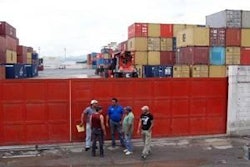
Crop producers have adopted precision technologies from auto steer in their tractors to apps that alert them when an irrigation system has shut down. But the livestock industry has been slower to put technology to work. “The livestock industry desperately needs more information,” says Drew Ryder, president of Feedlogic Corporation in Willmar, Minn. Ryder’s company has developed a feed meter that weighs the mass of feed in a line. Couple that information with the weight of feed delivered and producers have a simple way of measuring how much feed has been fed and are then able to project when the feed bin will be empty.
But that’s just the beginning as far as Ryder is concerned. If the technology he envisions becomes an industry standard, producers and feed mills alike won’t lack for information. However, for some in the animal production industry, the jury is still out as to the necessity of this technology.
Weighing technology
The flow meter developed by Feedlogic clamps onto a standard flex feed line between the bin and the first feeder, and measures feed flow by weight (pounds per minute) as feed is delivered through the line. That information is collected by telemetry and is pushed to a web server along with the duration between feed drops and how long each feed drop lasted.
That data alone will help a swine or poultry producer measure feed consumption, and identify feed lines that appear to be empty or not functioning. Producers could also use the information to calculate when the bin will be empty and schedule the next feed load accordingly. Managing deliveries so that feed arrives before a bin runs out—but not so early that stale feed cakes up at the bottom of a bin—can be difficult.
Some large livestock producers have employees devoted to scheduling feed deliveries to make certain correct diets are available. Other facilities have gone to a “keep full” system where feed trucks deliver at preset times and dates. But neither approach completely eliminates waste or inefficiency.
For example, under the “keep full” system, a truck may bring out 24 tons of feed to fill a bin, but if the bin only has room to take 20 tons, the mill must either dispose of the unneeded 4 tons, or include it in another feed order. However, if the producer had a feed meter and allowed the feed mill access to the data, the mill could better estimate how much feed was left and schedule accordingly.
Some industry support
Chris Hostetler, director of science and technology for the National Pork Board, sees value to this kind of information. “An amazing amount of effort goes into the scheduling and delivery of feed,” he says.
With feed prices high and projected to remain that way, reducing waste throughout the system is even more important. Just like yield monitors have helped crop producers fine tune fertilizer placement and planting rates, a feed meter may help producers and mills better coordinate feed manufacture and delivery.
Providing feed meters to customers in return for access to the information may be a way to turn feed from a commodity into a value-added service. “Shared knowledge creates a partnership,” Ryder says.
Better blending
In addition to better managing feed inventory, Ryder sees the potential to use technology to improve the process of blending micronutrients or animal health drugs directly into feed as it is flowing through lines rather than mixing large batches of feed.
Combining the FeedMeter with BlendTronic, also developed by Feedlogic, allows producers to blend micronutrients or antibiotics between the mixer and the feeder. The FeedMeter constantly monitors feed flow ahead of the injection point, and adjusts the injection rates in response to changes in the feed flow rate to maintain the correct inclusion rate. “Micronutrient injection systems failed in the past because they had no way to measure flow through the line,” Ryder says.
He believes this system allows producers to reduce costs because the feed mill could deliver one basic diet for a barn, and then the producer could add micronutrients or drugs to that basic diet to meet the animals’ needs. Blending on farm should also reduce the chance that a feed containing a controlled antibiotic is inadvertently put into the wrong bin.
Tracking antibiotics
Perhaps an even greater potential benefit is that the system’s injection processes are all automatically recorded, giving producers a detailed archive of what was administered, when and at what level. Feed mills can also potentially use BlendTronic to inject some micro-ingredients post-mixing and drive more efficiency into the milling process.
“This gives the industry a way to apply these micro products in a precise way, either post-mixing or on farm,” Ryder says. Using the FeedMeter on a feed line to track when and how much of a feed containing an animal health product was fed may allow a vet to better track the drug’s actual consumption with the optimal dosage.
Industry questions
John Goihl, president of Agri-Nutrition Services in Shakopee, Minn., has developed diets for a swine producer who has used the FeedMeter and Feedlogic’s FeedSaver blending technology. Better records are a key advantage of the system, he says.
However, Goihl and other swine experts are not convinced that the livestock industry is suffering from a dearth of information. While it might be interesting to know when or what pigs are eating, they aren’t sure how a producer will use that information to make better management decisions. The information that is most useful to producers comes when someone with good husbandry skills walks pens twice a day and can see what animal is going to get sick before the animal shows any symptoms, and adjusts feeders for optimal feed delivery.
Blending two diets, rather than feeding one phase of the feed budget until it is gone and then switching to the next phase, may allow growers to more closely match the pig’s growth curve which should – theoretically – improve feed efficiency. But Goihl has not seen sufficient data supporting improved feed efficiency to justify the practice compared to multi-phase feeding programs.
The problem isn’t the technology or the theory, Goihl says, it’s the inherent nature of swine and poultry – each pig and each bird is different. Crop producers can map low-lying areas in their fields or the areas with poorer soils and adjust inputs when they reach those areas. But pigs (or broilers) are individuals with a unique growth potential. If someone can eliminate the variability within a pen, then collecting more information about feed consumption may make more sense. Until then, growers aren’t sure they will realize enough gains in feed efficiency to offset the cost of the technology.
Challenges ahead
Ryder believes the advantages will extend beyond an individual barn or facility to the entire system, and could change how feed is made and delivered. Higher feed costs will force both producers and feed mills to find additional ways to reduce waste and increase efficiency throughout the system. Better information shared between facilities and feed mills will help both ends of the system become more cost efficient.
“We believe there is a lot of inefficiency and waste because producers and mills don’t know to coordinate better. You can’t expect mills to become super efficient if they don’t know when a facility is going to need feed,” he says. “What happens at the production level is what drives the mill’s business.”

















